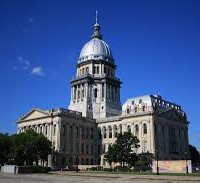GOP, Dems began to spar over school funding
By Mark Fitton
Illinois News Network
SPRINGFIELD — The debate over how to fund Illinois public schools began in earnest Tuesday, with Democrats questioning Republican Gov. Bruce Rauner’s plan for funding pre-kindergarten through high school education.
Tim Nuding, the governor’s budget chief, and Beth Purvis, his lead education adviser, pitched the plan to a Senate appropriations committee. They said the governor's plan would:
* Increase the state’s overall spending on primary and secondary education.
* Provide general state aid at the foundation level, or minimum recommended amount, of $6,119 per student. That would be the first time in seven years the state has met the mark.
* Pump an additional $75 million into early childhood education.
State Sen. Andy Manar, D-Bunker Hill, was among Democrats who questioned both the methods the administration used to reach its numbers and whether the proposal is ultimately fair to the state’s poorest schools.
“I’ve said publicly that’s a very good step forward, but I also think we’d be doing a disservice if we didn’t have a conversation about the fact that a foundation level of $6,119 for a district that has 99 percent poverty shouldn’t be the same as a foundation level for a district that has 4 percent poverty,” Manar said.
“That is the law today, and that needs to be changed because the expectations for both of those districts is the same, but we treat them differently,” he said.
The governor’s aides said Rauner is proposing using the existing state aid formula partly in an effort to get the most help to the most school districts and most students as soon as possible.
“I think the governor’s been very clear,” Nuding said. “He’s willing to talk about a formula rewrite or education-funding reform, but to say that this current formula doesn’t at least move in that direction – I would characterize that as inaccurate. I think it does to at least some degree.”
Primary and secondary education account for $6 billion to $7 billion of the state’s general-fund spending, Nuding said, and the governor feels so strongly about education he’s willing to move on it first and address the rest of the state budget later.
“What we’re saying is, this is what the governor supports,” Nuding said. “It’s the first $7 billion off the top of the $33 billion we’re going to bring in, [so] let’s do it and then let’s figure out the rest of it.”
Sen. Heather Steans, D-Chicago, said that didn’t seem to fit with the governor’s budgeting stances to date.
“So, in fact, we would be sort of adding … additional spending without doing anything on the revenue side, which seems pretty inconsistent with the discussion we’ve been hearing around MAP grant funding, for example,” Steans said.
MAP grants, essentially college tuition assistance, seem consistent with the governor’s theme of offering educational opportunities, yet the governor hasn’t seen fit to fund them, Steans argued.
“I don’t understand the inconsistency, frankly,” she said.
Nuding said the administration has proposed higher-education funding options, including for Monetary Award Program, or MAP grants, for fiscal year 2017, but Democrats so far simply haven’t liked the choices.
And he argued the money Steans was discussing was for fiscal year 2016, which is now nearly two-thirds completed.
“Candidly, there’s no appropriation and no money for higher ed because it all got spent,” Nuding told the committee.
Sen. Matt Murphy, R-Palatine, was among GOP senators who expressed concern over suggestions that categorical grants, such as for special education, be stripped from the school-funding package and applied elsewhere in an attempt to bolster high-poverty districts.
Those grants are “really the only money we get [from the state], for the most part,” he said of many suburban districts.
Nuding and Purvis said the governor’s office is well-aware of Illinois’ overreliance on property taxes and its negative impact on poorer school districts.
With that said, however, the administration believes full funding of the state aid formula is the best way to immediately help the most students.
The governor also is “concerned about moving large chunks of money away from some school districts to other districts because of the political realities. That makes a plan very difficult to pass,” Nuding said.
The governor’s proposal for primary and secondary education will return to hearings next week, when the Illinois State Board of Education chairman and superintendent are expected to testify.
The administration’s overall estimate for state income is likely to get more attention then, too, as the General Assembly’s bipartisan forecasting arm has that income projected closer to $32 billion than the administration’s $33 billion.
Economists for the legislative agency, the Commission on Government Forecasting and Accountability, said in a separate hearing Tuesday that although the administration’s numbers may have merit, they also hinge upon actions that may or may not to be taken by the Legislature.

